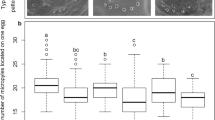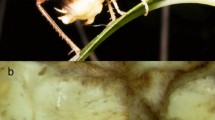Abstract
Diploid males in haplo-diploid insects are sterile, because they produce diploid sperm. Our previous report revealed that early males of the Japanese paper wasp Polistes chinensis antennalis are diploid but did not reveal how often this occurs. We analyzed the genotypes of early males using six microsatellite markers. Two of the 41 early males (5%) from six colonies were haploid, but the other males were diploid. This evidence suggests that we can ignore the reproductive success of the early males of P. chinensis antennalis.
Similar content being viewed by others
Avoid common mistakes on your manuscript.
In social insects, workers may have more alternative reproductive options besides helping than previously thought. As well as potentially producing males, workers can also produce females after mating with early males that emerge along with the first workers (Strassmann 1981; Suzuki 1985, 1997; Ono 1989; Page et al. 1989). In this case, early males can gain fitness benefits via their worker mates, because the mated workers produce diploid offspring bearing the genes of these males.
Recently, we (Tsuchida et al. 2002) reported that Polistes chinensis antennalis produced early males that were diploid. Diploid male production seems to be an example of genetic load, because these males produce diploid sperm (Hung et al. 1974; Naito and Suzuki 1991; Stouthamer et al. 1992). We have not yet reported how commonly male diploidy occurs in P. chinensis antennalis. Here, we use microsatellite markers to evaluate the frequency of diploid males in this species.
Six of 13 identified microsatellite loci for P. chinensis antennalis (Tsuchida et al. 2003a) were analyzed. The sequences, including tandem repetitive regions, have been deposited in DDBJ, under accession numbers AB083012–AB083024 for loci Pc01–Pc83, respectively.
Individual DNA was prepared from the head of each wasp. Each head was smashed with a pestle in 300 µl of extraction buffer, containing 150 mM NaCl, 10 mM Tris-HCl (pH 8.0), 10 mM EDTA, 0.1% SDS, and 30 ng proteinase K, in a 1.5-ml tube. The solutions were kept overnight at 37°C, and then DNA was extracted using phenol chloroform. Isolated DNA was maintained in TE buffer at 4°C until polymerase chain reaction (PCR) could be performed. The 10-µl PCR solution comprised 1 µl of diluted genomic DNA (≈1 ng), 1 µl of primer mix (2.5 µM), 0.1 µl of 10 mM dNTP mix, 0.05 µl Taq polymerase solution (5 units/µl, TAKARA), 1 µl of 10× buffer (provided with Taq, 1.5 mM in the final volume), and 6.85 µl of dH2O. PCR was carried out using a Thermal cycler (TP-240, TAKARA). The products were run on an 8–10% native acrylamide gel and visualized using silver staining (Bassam et al. 1991). Primer sequences and PCR profiles are published elsewhere (Tsuchida et al. 2003a). Genotypings were conducted using 1D Image Analysis software (Kodak) installed on a Macintosh computer.
We genotyped adult females and early males of six colonies (one colony in 1995 and five colonies in 2000) nested in or around the Yanagido campus of Gifu University. Here, we define an "early male" as a male that emerged before the middle of July, almost 2 weeks before the emergence of fall reproductive males. For colony 95013, early males were collected from the nest in the field at 3-day intervals and stored at −80°C. For colonies 20002 and 20029, nests and queens were collected in the field before worker emergence. The colonies were kept under controlled conditions (14L:10D, 25±1°C) and supplied with mealworm, diluted honey solution, and water ad libitum. For the remaining three field colonies, all colony members and the nests were collected after visual inspection of early males in the nests. These colonies were then transported to the laboratory and reared with mealworm, diluted honey solution, and water ad libitum. All adults were stored at −80°C until DNA extraction. DNA was, as a rule, extracted from all stored adults, except for colony 95013, in which 18 females and 10 early males were genotyped out of the 22 females and 18 early males.
Table 1 shows the genotypes for the six colonies. All but two early males in colony 20040 were heterozygous at one or more loci, indicating that at least 95% (39/41) of early males in this population were diploid. The probability of being homozygous for the remaining two males (\( {{\prod\limits_{}^{} {n^{2}_{i} } }} \), where n i is the allele frequency of allele i at locus n) was very low when calculated using the gene frequencies of the nestmate females (P=0.008 and 0.0007 for the two males). Therefore, these males were deduced to be haploid. In colonies 95013 and 20029, the observed genotypes of all early males were also present in the females.
Our previous report (Tsuchida et al. 2002) presented evidence, based on allozyme markers and a cytological study, that early males in a colony of P. chinensis antennalis are diploid. In addition, we suggested that the emergence of diploid males could be explained by a complementary sex determination model with one sex determining locus (CSD model; Whiting 1943). Under the CSD model, if a mother mates singly, then the sex ratio of female offspring and diploid males within a colony is expected to be 1:1. Colony 95013 produced 22 females and 18 diploid males, of which 10 males were genotyped in this study, and the sex ratio was not significantly different from parity (Tsuchida et al. 2002). The same is true for colony 20029, which produced 23 females and 24 diploid males (χ2=0.021, P>0.05). In contrast, genotypes in colony 20002 made it difficult to deduce the pedigree of this colony; we need more loci to construct a reliable pedigree for these colony members.
For the remaining colonies, pedigree construction was difficult, because several contradictions between the genotypes of colony members across loci were observed. In colony 20040, the queen genotype was not compatible with those nestmate females and/or males in four of five loci (Table 1), suggesting that queen replacement had occurred. In colonies 20057 and 20076, several genes of the nestmate females were not observed in early males and vice versa. These findings strongly suggest that immigration by either workers or early males had occurred in the two colonies. In Polistes wasps, internidal drifting of workers has been observed, but the frequency is very low (Hibino and Kasuya 1980; Kasuya 1981; Tsuchida and Itô 1987). Kasuya (1983) reported that early males of P. chinensis antennalis were expelled from the natal nest by the workers. We also observed such expelling behavior in one early-male-producing colony; these males attempted to copulate with worker nestmates but were rejected and expelled with chasing and biting behavior by the workers, such that the early males left the natal nest more rapidly than did the workers (K. Tsuchida, unpublished data). These lines of evidence strongly suggest that colonies 20057 and 20076 did not produce early diploid males.
In P. chinensis antennalis, parentage of males is shared by queen and workers in queen-right condition (Miyano 1983; Tsuchida et al. 2003b), and that of females has been implicitly assumed to be contributed by workers mating with early males (Suzuki 1998). The use of microsatellite markers in this study revealed that 95% of early males were diploid, and only 2 of the 41 genotyped males were probably haploid early males. It is a matter of course that this percentage is an overestimate, because the number of early males produced varied between colonies. In this study, colonies 95013 and 20029 produced more than half of the early males. However, we found that the frequency of early-male-producing colonies within a population was low [5.2% (4/77) in 1993 through 1995 (Tsuchida et al. 2002)]. These lines of evidence strongly suggest that haploid early males are extremely novel and that in P. chinensis antennalis they are a result of accident rather than a reproductive strategy. Diploid males surviving to adulthood are practically sterile, because they produce diploid sperm if they are fertile (Hung et al. 1974; Naito and Suzuki 1991; Stouthamer et al. 1992). Early diploid male production should impose substantial cost at the beginning of the ergonomic stage in P. chinensis antennalis.
References
Bassam BJ, Caetano-Anolles G, Gresshoff PM (1991) Fast and sensitive silver staining of DNA in poloyacrylamide gels. Anal Biochem 196:80–83
Hibino Y, Kasuya E (1980) Reconstruction of nests by Polistes jadwigae and Polistes chinensis antennalis workers. Appl Entomol Zool 15:190–192
Hung ACF, Vinson SB, Summerlin JW (1974) Male sterility in the imported red fire ant, Solenopsis invicta. Ann Entomol Soc Am 67:909–912
Kasuya E (1981) Nest foundation by a single worker of the Japanese paper wasp Polistes chinensis antennalis (Hymenoptera: Vespidae). Insectes Soc 28:341–342
Kasuya E (1983) Social behavior of early emerging males of a Japanese paper wasp, Polistes chinensis antennalis (Hymenoptera: Vespidae). Res Popul Ecol 25:143–149
Miyano S (1983) Number of offspring and seasonal changes of their body weight in a paper wasp, Polistes chinensis antennalis Pérez (Hymenoptera: Vespidae), with reference to male production by workers. Res Popul Ecol 25:198–209
Naito T, Suzuki H (1991) Sex determination in the sawfly Athalia rosae ruficornis: occurrence of triploid males. J Hered 82:101–104
Ono M (1989) Multiple-comb nest foundation by a single inseminated worker of the temperate paper wasp, Polistes snelleni Saussure (Hymenoptera: Vespidae). J Ethol 7:57–58
Page RE, Post DC, Metcalf RA (1989) Satellite nests, early males, and plasticity of reproductive behavior in a paper wasp. Am Nat 134:731–748
Stouthamer R, Luck RR, Werren JH (1992) Genetics of sex determination and the improvement of biological control using parasitoids. Environ Entomol 21:427–435
Strassmann JE (1981) Evolutionary implications of early male and satellite nest production in Polistes exclamans colony cycles. Behav Ecol Sociobiol 8:55–64
Suzuki T (1985) Mating and laying of female-producing eggs by orphaned workers of a paper wasp, Polistes snelleni (Hymenoptera: Vespidae). Ann Entomol Soc Am 78:736–739
Suzuki T (1997) Worker mating in queen-right colonies of a temperate paper wasp. Naturwissenshcaften 84:304–305
Suzuki T (1998) Paradox of worker reproduction and worker mating in temperate wasps, Polistes chinensis and P. snelleni (Hymenoptera Vespidae). Ethol Ecol Evol 10:347–359
Tsuchida K, Itô Y (1987) Internaidal drifting and dominance behaviour in Polistes jadwigae Dalla Torre workers (Hymenoptera: Vespidae). J Ethol 5:83–85
Tsuchida K, Nagata N, Kojima J (2002) Diploid males and sex determination in a paper wasp, Polistes chinensis antennalis (Hymenoptera: Vespidae). Insectes Soc 49:120–124
Tsuchida K, Saigo T, Tsujita S, Takeuchi K, Ito N, Sugiyama M (2003a) Polymorphic microsatellite loci for the Japanese paper wasp, Polistes chinensis antennalis (Hymenoptera: Vespidae). Mol Ecol Notes 3:384–386
Tsuchida K, Saigo T, Nagata N, Tsujita S, Takeuchi K, Miyano S (2003b) Queen-worker conflicts over male production and sex allocation in a primitively eusocial wasp. Evolution (in press)
Whiting PW (1943) Multiple alleles in complementary sex determination of Habrobracon. Genetics 28:365–382
Acknowledgements
We express our sincere thanks to B. Kranz for reviewing and improving our English. We are very grateful to K. Kudo for his comments on an earlier version of this manuscript. Comments of two anonymous reviewers were helpful in improving our manuscript. This study was supported in part by grants-in-aid from the Japan Ministry of Education, Science and Culture (11440228, 11833001 and 12304048).
Author information
Authors and Affiliations
Corresponding author
About this article
Cite this article
Tsuchida, K., Saigo, T., Tsujita, S. et al. Early male production is not linked to a reproductive strategy in the Japanese paper wasp, Polistes chinensis antennalis (Hymenoptera: Vespidae). J Ethol 22, 119–121 (2004). https://doi.org/10.1007/s10164-003-0109-8
Received:
Accepted:
Published:
Issue Date:
DOI: https://doi.org/10.1007/s10164-003-0109-8




